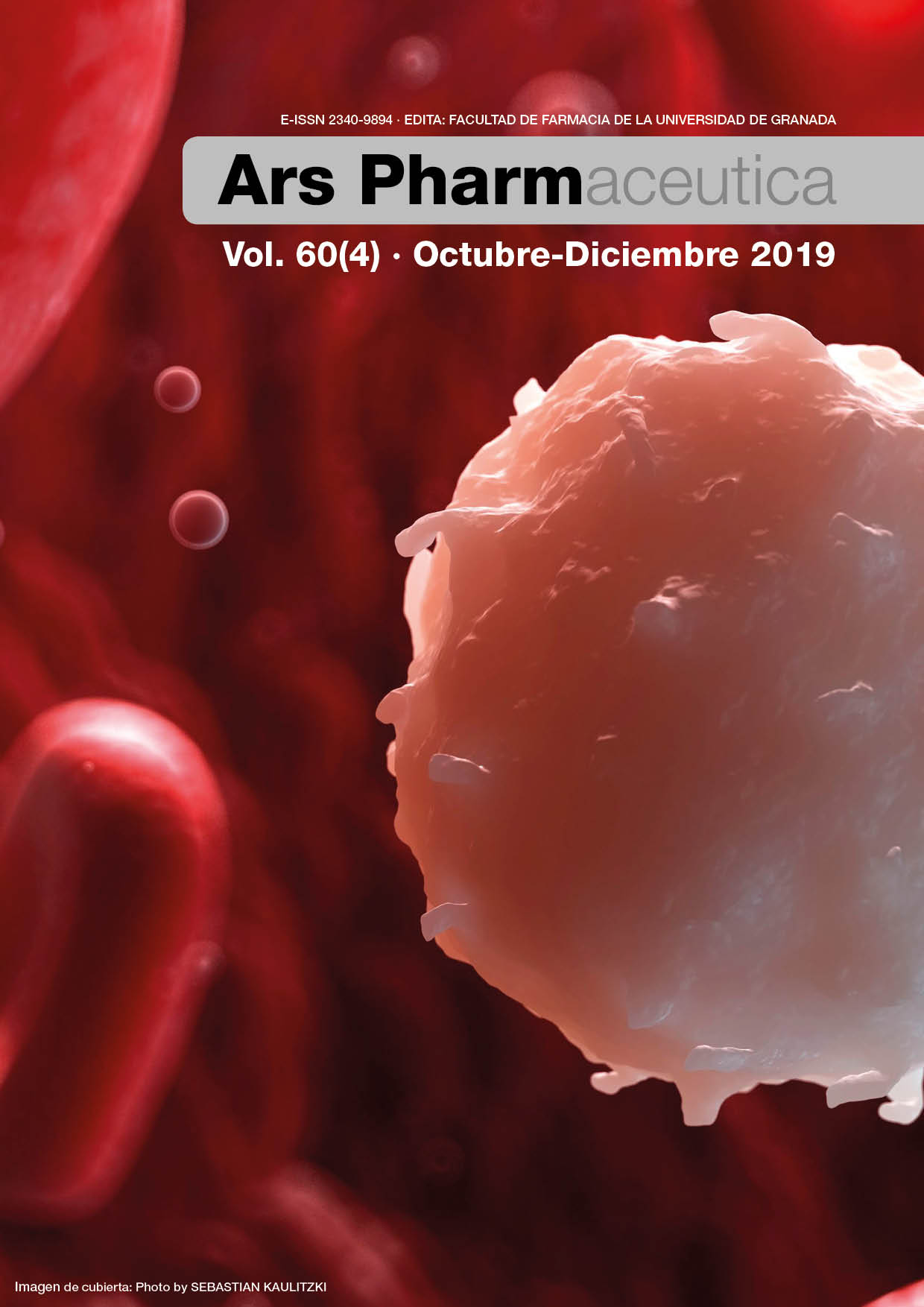First preformulation studies in the development of a pharmaceutical suspension of Praziquantel microparticles destined to the oral route of drug administration
DOI:
https://doi.org/10.30827/ars.v60i4.9986Keywords:
Aqueous Suspension, Electrophoresis, Praziquantel, Schistosomiasis, SedimentationAbstract
Introduction: One of the first-line drugs against schistosomiasis is Praziquantel. Up to now, numerous oral solid dosage forms have been developed, being they considered of little help to elder patients, pediatrics, and Veterinary. Initial steps in the development of preformulation studies aiming the design of a Praziquantel liquid pharmaceutical dosage form to be administered orally are described.
Method: Size and shape of Praziquantel particles were characterized by scanning electron microscopy. Furthermore, it was investigated the effect of pH and type of electrolyte and its concentration in the aqueous dispersion media on the behaviour of the suspensions. To that aim, electrokinetic determinations (zeta potential) and ultraviolet-visible spectrophotometry measurements (turbidimetry as a function of time) were done.
Results: Drug particles were characterized by an acicular shape and a micrometer size (heterogeneous size distribution). It was observed that controlling the composition of the aqueous dispersion media, in terms of pH and electrolytes, helped in defining the surface electrical charge of the drug particles and, thus the sedimentation profile, obtaining the more adequate system for the oral route of drug administration (flocculated system).
Conclusions: Initial conditions to formulate aqueous Praziquantel suspensions for the oral route have been defined. An appropriate control of the composition of the external phase of the suspension is a key aspect when establishing the best liquid pharmaceutical system (flocculated) for this administration route.
Downloads
References
Zanolla D, Perissutti B, Passerini N, et al. A new soluble and bioactive polymorph of praziquantel. Eur J Pharm Biopharm. 2018; 127:19-28. doi: 10.1016/j.ejpb.2018.01.018.
World Health Organization - Weekly Epidemiological Record. Schistosomiasis: number of people treated worldwide in 2014. Wkly Epidemiol Rec. 2016; 91(5):53-60.
Hong ST. Albendazole and praziquantel: review and safety monitoring in Korea. Infect Chemother. 2018; 50(1):1-10. doi: 10.3947/ic.2018.50.1.1.
Conway J, Bero L, Ondari C, Wasan KM. Review of the quality of pediatric medications in developing countries. J Pharm Sci. 2013; 102(5):1419-1433. doi: 10.1002/jps.23474.
Qian M, Wei L, Hao L, Tang S. Pharmacokinetics of new high-concentration and long-acting praziquantel oily suspensions after intramuscular administration in cattle. J Vet Pharmacol Ther. 2017; 40(5):454-458. doi: 10.1111/jvp.12378.
Tang S, Chen L, Guo Z, et al. Pharmacokinetics of a new ivermectin/praziquantel oil suspension after intramuscular administration in pigs. Vet Parasitol. 2012; 185(2-4):229-235. doi: 10.1016/j.vetpar.2011.10.021.
Mourão SC, Costa PI, Salgado HR, Gremião MP. Improvement of antischistosomal activity of praziquantel by incorporation into phosphatidylcholine-containing liposomes. Int J Pharm. 2005; 295(1-2):157-162. doi: 10.1016/j.ijpharm.2005.02.009.
Xie S, Pan B, Shi B, et al. Solid lipid nanoparticle suspension enhanced the therapeutic efficacy of praziquantel against tapeworm. Int J Nanomedicine. 2011; 6:2367-2374. doi: 10.2147/IJN.S24919.
Malhado M, Pinto DP, Silva AC, et al. Preclinical pharmacokinetic evaluation of praziquantel loaded in poly (methyl methacrylate) nanoparticle using a HPLC-MS/MS. J Pharm Biomed Anal. 2016; 117:405-412. doi: 10.1016/j.jpba.2015.09.023.
Torabi N, Dobakhti F, Faghihzadeh S, Haniloo A. In vitro and in vivo effects of chitosan-praziquantel and chitosan-albendazole nanoparticles on Echinococcus granulosus Metacestodes. Parasitol Res. 2018; 117(7):2015-2023. doi: 10.1007/s00436-018-5849-z.
Arias JL, Gómez-Gallo A, Delgado AV, Gallardo V. Study of the stability of Kollidon SR suspensions for pharmaceutical applications. Colloids Surf A Physicochem Eng Aspects. 2009; 338:107-113. doi: 10.1016/j.colsurfa.2009.01.001.
López-Viota M, Arias JL, Gallardo V. Propiedades fisicoquímicas básicas de los sistemas dispersos. En: Martínez Pacheco R, editor. Tratado de Tecnología Farmacéutica. Vol. 2. 1ª ed. Madrid: Editorial Síntesis, S.A.; 2016. p. 171-196.
Cózar-Bernal MJ, Gallardo V, Sáez-Fernández E, et al. Role of the electrokinetic properties on the stability of mebendazole suspensions for veterinary applications. Int J Pharm. 2010; 393(1-2):161-166. doi: 10.1016/j.ijpharm.2010.04.031.
Dragan ES, Mihai M, Schwarz S. Complex nanoparticles based on chitosan and ionic/nonionic strong polyanions: formation, stability, and application. ACS Appl Mater Interfaces. 2009; 1(6):1231-1240. doi: 10.1021/am900109u.
Piazzini V, Landucci E, D’Ambrosio M, et al. Chitosan coated human serum albumin nanoparticles: a promising strategy for nose-to-brain drug delivery. Int J Biol Macromol. 2019; 129:267-280. doi: 10.1016/j.ijbiomac.2019.02.005.
Gallardo Lara V, Ruiz MA, López-Viota J, Salcedo J, Delgado AV. Electrokinetic study of omeprazole drug in aqueous suspensions. Colloids Surf A Physicochem Eng Aspects. 2003; 218:21-26. doi: 10.1016/S0927-7757(02)00589-7.
Downloads
Additional Files
Published
How to Cite
Issue
Section
License
Copyright (c) 2019 María Luisa Badillo-García, Jose Luis Arias Mediano

This work is licensed under a Creative Commons Attribution-NonCommercial-ShareAlike 4.0 International License.
The articles, which are published in this journal, are subject to the following terms in relation to the rights of patrimonial or exploitation:
- The authors will keep their copyright and guarantee to the journal the right of first publication of their work, which will be distributed with a Creative Commons BY-NC-SA 4.0 license that allows third parties to reuse the work whenever its author, quote the original source and do not make commercial use of it.
b. The authors may adopt other non-exclusive licensing agreements for the distribution of the published version of the work (e.g., deposit it in an institutional telematic file or publish it in a monographic volume) provided that the original source of its publication is indicated.
c. Authors are allowed and advised to disseminate their work through the Internet (e.g. in institutional repositories or on their website) before and during the submission process, which can produce interesting exchanges and increase citations of the published work. (See The effect of open access).























